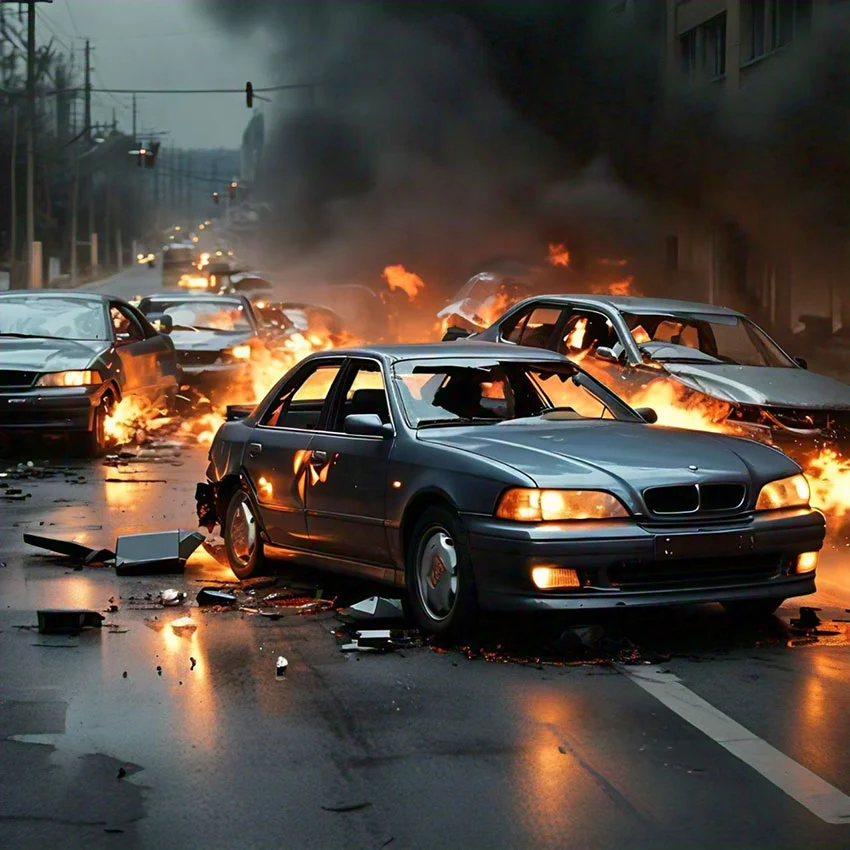Chain-Reaction Car Crash: What To Do?
A chain-reaction car crash happens when one vehicle collides with another, setting off a series of collisions involving multiple cars. These accidents are often seen on busy highways or during rush hour when traffic is tight, and drivers have little time to react.
In these situations, determining who’s at fault can be tricky. The general rule is that the driver who caused the first collision is often held responsible, but things can get complicated when multiple cars are involved. Each driver must maintain a safe following distance, so if you rear-end someone after they were hit, you might still share some of the blame.
If you find yourself in a chain-reaction crash, here are the first few things you need to do:

Ensure Your Safety First
Accidents, especially those involving multiple vehicles, can quickly escalate if you’re in a dangerous spot on the road. The initial impact can lead to secondary crashes, so staying alert and protecting yourself from further harm is critical. Call 911 or local emergency services immediately to report the accident. Even if the damage seems minor, professional help may be needed to manage the situation safely.
After contacting the authorities, if you can, check yourself for any signs of pain, dizziness, or bleeding, and look for injuries that might not be immediately noticeable, like whiplash or internal damage. If you feel stable or notice no injuries, assess others involved in the accident. Offer assistance if it’s safe, but avoid moving anyone unless they’re in immediate danger. Waiting for emergency services to provide proper medical care is always the best course of action in such situations.
To prevent further accidents, move your vehicle out of the traffic flow, but only if it’s safe. Leaving your car in the middle of the road could lead to another pileup accident, especially in high-traffic areas or during poor visibility. However, if you have serious injuries, your car can’t run, or the road has too much debris due to the traffic, don’t move your car and stay inside with your seatbelt fastened until help arrives.
Document the Scene
After securing your safety, gathering evidence is the next step. A chain-reaction crash can involve multiple cars, and clear documentation of the accident scene can help prove who is at fault. Photographic evidence of the damage and overall setting will support your insurance claim or any legal proceedings that might follow.
To document the scene, take clear, wide-angle photos of your vehicle, the other cars involved, and the entire accident site. Capture road conditions, skid marks, and the position of the vehicles relative to each other. It’s also helpful to note any contributing factors like poor weather or visibility. Make sure to collect witness information, as their accounts can also be crucial in determining what happened.
If uninsured, looking into non-traditional or alternative financing options, such as borrowing from a local credit union or taking advantage of a no denial payday loan bad credit, can be a temporary solution for managing unexpected expenses while waiting for an insurance payout or settlement, whichever is decided.
Exchange Information with Other Drivers
Once you’ve documented the scene, you must exchange information with the other drivers involved. This includes getting their names, phone numbers, insurance details, and vehicle registration information.
When exchanging information, keep things professional and stick to the facts. Take photos of driver’s licenses and insurance cards to ensure accuracy. If anyone else in the crash refuses to cooperate or share details, note their license plate number and share it with the police when they arrive.
This step is important because it ensures that you have the necessary details to file an accurate report with your insurance company. It also provides a record in case disputes arise later about who is responsible for the damages. Generally, having all the facts helps keep the process smooth and avoids any misunderstandings down the line.
Report the Accident to Authorities
In most cases, you’ll need to report the accident to the police, especially when multiple vehicles are involved. Their report will serve as an official record of the crash and help determine who’s at fault. You also need to show your driver’s license, car registration, and insurance details and answer a few questions.
When the police arrive, give a clear and honest account of what happened, but avoid speculation or assigning blame. Stick to the facts and let the officers document the scene. They may ask you and other drivers for a statement. Be sure to request a copy of the police report once it’s completed, as this will be critical for insurance and legal purposes.
Contact Your Insurance Company
Once you’ve gathered information and spoken to the authorities, your next step is to notify your insurance company. Reporting the accident promptly helps ensure that your claim is processed efficiently and correctly. Your insurer will walk you through the next steps, which may include handling any claims made against you by other drivers involved.
When contacting your insurance company, provide them with all relevant information, including photos, contact details for the other drivers, and a copy of the police report. Be sure to follow their instructions closely and ask any questions you might have about your coverage or liability. However, if you need medical attention and can’t speak to them right away, ask for additional time or have someone else contact them on your behalf.
Final Thoughts
Being involved in a chain-reaction car crash can be overwhelming and stressful. It’s natural to feel shaken or unsure about what to do next, but keeping a clear head and taking the right steps can help protect your safety and your rights.
Remember, the safety of everyone involved comes first, and handling the aftermath with care will make the process smoother. Take the time you need to gather yourself, follow the proper procedures, and don’t hesitate to seek professional advice if necessary.
